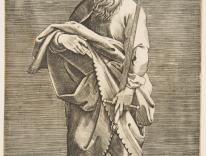The intrepid Harold Bloom once called the New Testament the greatest act of plagiarism in the history of literature. That might sound hyperbolic; but if you include, along with the Hebrew Scriptures (the Tanakh, in Jewish usage), the vast Jewish inter-testamental literature not included in the Jewish canon of the Bible (“outside books,” as the rabbis called them), it’s a reasonable assessment. Indeed, almost every verse in the New Testament finds some sort of echo or parallel in the Tanakh or other ancient Jewish literature, including the much later Talmud. Such echoes surely help explain why Christians have written commentaries on the books of the “Old Testament” for two thousand years. Now, in The Jewish Annotated New Testament, Jewish scholars—fifty of them—take their turn at bat. It’s a magnificent achievement, comparable in its way to the Jerome Biblical Commentary, written by Roman Catholic scholars in the heady days after the Second Vatican Council. I cut my biblical teeth on the JBC and still revere it, but the Jewish commentary under review is much more user-friendly,- appealing to a broader and biblically less sophisticated audience.
First let me describe its structure. The text reproduces the New Revised Standard Version of the New Testament, the closest to the Greek of any modern translation. Each book comes with a brief introduction addressing standard issues of date, authorship, provenance, audience, and literary form and structure. But unique to this volume is a discussion of the given book’s relationship to Judaism. Was it familiar with Jewish belief and rituals or unfamiliar? Friendly to Judaism or antagonistic? Supersessionist or inclusive? These commentaries, all shorter than one page, are filled with references to the Tanakh, the Talmud, and the “outside books” as well. Though not perhaps immediately useful to the average reader (how many Christians, or Jews for that matter, have an edition of the Mishnah or the Dead Sea Scrolls to hand?), this plenitude of references illuminates the extensive resonance between the New Testament and Jewish sacred (and not-so-sacred) texts. And the commentaries contain helpful maps, charts, and diagrams, along with sidebar essays that are informative, clear, and extremely pertinent.
The second half of the book contains thirty brief but substantive essays on almost every imaginable topic relating to the New Testament and Judaism, from “Jewish Movements of the New Testament Period” to “Paul and Judaism, Afterlife and Resurrection,” “Food and Table Fellowship,” and “Jesus in Rabbinic Tradition.” My favorite among these essays is Daniel Boyarin’s “Logos, a Jewish Word: John’s Prologue as Midrash,” which argues that the idea of the Trinity may have begun “precisely in pre-Christian Jewish accounts of the second and visible God that we find in many early Jewish writings.” And with regard to the psychedelic Book of Revelation, with its visions of Christ as a seven-eyed, seven-horned Lamb (5:6), and as a flame-eyed mounted warrior whose robe is dipped in blood (19:11), scholar David Frankfurter advances the volume’s most arresting thesis. “Increasingly,” he writes, “scholars are looking at Revelation as a Jewish text that reveals a heavenly Christ rather than a Christian text with Jewish attributes”—a text, he asserts, possessing “no sense of a Christianity or even a Jesus-devotion unmoored from Judaism.” Given the uses that Revelation has been put to in Christian history, not least in our own day, I for one would be happy to give it back to the Jews. But it is nonetheless unsettling to think that the Christ of Revelation is not Jesus of Nazareth.
The tone throughout the volume is scholarly and respectful. Nevertheless, the question that runs through these commentaries like Rahab’s scarlet cord is a provocative one: how anti-Jewish is the New Testament? For example, did Jesus assert, as Mark writes (7:19), that all foods are clean—thereby abrogating Jewish dietary laws? Or, following Matthew (5:17), who conspicuously drops Mark’s saying, did Jesus say: “Do not think that I have come to abolish the law or the prophets. I have come not to abolish but to fulfill”? (The scholarly consensus, both Christian and Jewish, would favor Matthew.) Matthew and John are the most Jewish of the four gospels, but Matthew has the infamous “blood cry”: “the self-curse of ‘all the people’ that Jesus’ ‘blood be on us and on our children’” (27:25), and John has Jesus say to his Jewish audience: “You are from your father the devil, and you choose to do your father’s desires” (8:44). These statements have had horrific consequences in history, and the commentators here do their best to put these fatal words in their proper context.
And what about Paul? As the “founder of Christianity,” was he an apostate, the original self-hating Jew? There seems to be a rabbinic difference of opinion. In his essay “Paul and Judaism,” Mark D. Nanos asserts that “Paul did not leave Judaism,” and that “Paul’s comments about circumcision and Torah--observance...provide for continued Jewish identity and Torah--observance for Jesus-following Jews, alongside of Torah--respectful behavior for Jesus-following non-Jews.” And Shaye J. D. Cohen in his commentary on Galatians writes that “Paul’s attack on the law was addressed to Gentile believers in Christ; his primary concern was to make sure that they did not begin to observe the Torah. Nowhere, in his letters...does Paul attempt to convince Jews to abandon the Torah.” Yet in commenting on 2 Corinthians, Alan J. Avery-Peck writes: “It is debatable whether Paul is only insisting that the law is not obligatory for Gentiles, or whether he denies its applicability to Jews as well.” The problem with Paul is that he was a brilliant polemicist. The views he expresses in his early Letter to the Galatians—a fairly negative assessment of Torah—seem far more nuanced in his Letter to the Romans, which, as Nanos points out, “is a key text for those seeking to reverse the legacy of contempt for Jews and Judaism.”
In the end, this volume shows the attempt to find a unified attitude toward Jews and Judaism in the New Testament to be an impossible task. The NT was composed in various communities in Judea or Galilee, Syria, Asia Minor, and even Rome over a period of one hundred years. Even with the slow rhythms of the ancient world, times changed, and different issues and emphases emerged. Consider the divergent nature of some of the contributors’ summary judgments: the Letter to the Hebrews “is often perceived as the New Testament’s most anti-Jewish text,” while the Letter of James “with two references (1:1; 2:1) removed…could function as an address to synagogue communities in the Diaspora”; the author of 1 and 2 Peter, meanwhile, “at home in both Jewish and Greek traditions,” was championed by “Christians who continued to observe a form of Jewish law that emphasized purity regulations and ritual immersion.”
The Jewish Annotated New Testament is a marvelously bounteous compilation. Its back sections include some of the most helpful material I’ve ever seen in a commentary: the Jewish calendar; weights and measures; chapter and verse differences between standard Christian Bibles and the Hebrew Bible; a chart in parallel columns of the Jewish, Protestant, and Roman Catholic/Orthodox biblical canons; divisions and tractates of the Mishnah, Talmud, and Tosefta; and a supremely useful list of parallel texts in the Synoptic Gospels. The glossary itself is worth the price of the book.
From such riches one emerges, perhaps inevitably, with the question: For whom is this book meant? In their preface, editors Amy-Jill Levine and Marc Zvi Brettler remind us that “it is important for both Jews and non-Jews to understand how close, in many aspects, significant parts of the New Testament are to the Jewish practices and beliefs reflected in the works of the Dead Sea Scrolls, Philo and Josephus, the Pseudepigrapha and Deuterocanonical literature, the Targumim (Aramaic translations of the Bible), and slightly later rabbinic literature.” Along with this literature, the New Testament fills a huge gap in the four-to-five-hundred-year period between the foundations of Jewish beliefs and practices, the Tanakh (completed in the second century BCE) and the two Talmuds (completed in the fifth and sixth centuries CE). As such it forms a precious repository. In fact, as Ross S. Kraemer lovingly asserts in her essay “Jewish Family Life in the First Century CE,” “Some of the most evocative evidence for Jewish family life in the first century comes from the New Testament Gospels.”
The editors invoke the term “holy envy,” coined by the late Lutheran New Testament scholar (and dean of Harvard Divinity School) Krister Stendahl, to raise the possibility that a religious tradition other than our own may incite us to appreciation of the beauty and significance of its traditions and practices. This is particularly true of the relationship between Judaism and Christianity, which has too long expressed itself in mutual indifference, sibling rivalry, and even fratricide. While admitting that “many Jews are unfamiliar with, or even afraid of, reading the New Testament,” Levine and Brettler feel that “familiarity with the New Testament helps Jews to recover some of our own history” and that “study of the New Testament also has made us better, mor informed Jews.” May our study of their study make us better Christians as well!
Please email comments to [email protected] and join the conversation on our Facebook page.
Previous Story
Snowe Job
Next Story
The Kingdom of What’s Happening Next

